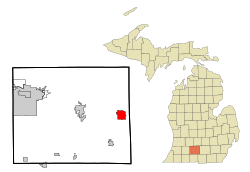Albion | |
|---|---|
City | |
 Location of Albion, Michigan | |
| Coordinates: 42°14′48″N 84°45′12″W / 42.24667°N 84.75333°W | |
| Country | United States |
| State | Michigan |
| County | Calhoun |
| Area | |
| • Total | 4.50 sq mi (11.66 km2) |
| • Land | 4.41 sq mi (11.42 km2) |
| • Water | 0.09 sq mi (0.24 km2) |
| Elevation | 951 ft (290 m) |
| Population (2020) | |
| • Total | 7,700 |
| • Density | 1,746.03/sq mi (674.14/km2) |
| Time zone | UTC-5 (Eastern (EST)) |
| • Summer (DST) | UTC-4 (EDT) |
| ZIP code | 49224 |
| Area code | 517 |
| FIPS code | 26-00980[2] |
| GNIS feature ID | 0619906[3] |
Albion is a city in Calhoun County in the south central region of the Lower Peninsula of the U.S. state of Michigan. The population was 7,700 at the 2020 census. Albion is part of the Battle Creek Metropolitan Statistical Area.
The earliest English-speaking settlers also called this area The Forks, because it is at the confluence of the north and south branches of the Kalamazoo River. In the early 20th century, immigrants came to Albion from various eastern European nations, including the current Lithuania and Russia. More recently, Latino immigrants have come from Mexico and Central America. The Festival of the Forks has been held annually since 1967 to celebrate Albion's diverse ethnic heritage.
Since the 19th century, several major manufacturers were established in Albion, which became known as a factory town. This changed after several manufacturers closed. In the 21st century, Albion's culture is changing to that of a college town whose residents have a strong interest in technology and sustainability. Albion College is a private liberal arts college with a student population of about 1,250. Albion is a sister city with Noisy-le-Roi, France.
- ^ "2020 U.S. Gazetteer Files". United States Census Bureau. Retrieved May 21, 2022.
- ^ "U.S. Census website". United States Census Bureau. Retrieved 2008-01-31.
- ^ "US Board on Geographic Names". United States Geological Survey. 2007-10-25. Retrieved 2008-01-31.


